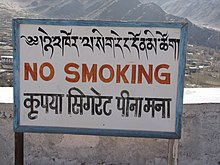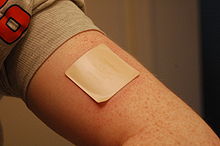Tobacco smoking is an activity that has come under fairly stringent controls in most countries. Smoking is prohibited in most or all indoor public spaces and inside public transport such as aircraft, buses and trains. Restrictions and enforcement vary considerably from place to place; for details see the rest of this article and our articles on particular destinations.
Related products, such as e-cigarettes are also regulated in many countries, and some of the liquids sold for them are outright illegal in some places. Smokeless tobacco products are also regulated in most parts of the world.
Border controls
[edit]Tobacco
[edit]Many countries have restrictions on the quantity of cigarettes or tobacco that can be brought into the country. In many countries, tobacco products are taxed heavily, so those importing more than a few packets of these products should expect to pay import duties. On the other hand, many countries also have facilities that permit departing travellers to purchase these same products, duty free, at the border, as they leave the country.

Tobacco products vary enormously in price around the world, mainly because different countries or states tax them differently. For example, the price of a pack of Marlboro (converted to US dollars) ranges from about $2.50 in the Philippines (where they are common, made locally under license) to well over $14 in Canada (where they are an imported luxury, subject first to duty and then to stiff taxes). In both cases, local brands are considerably cheaper.
It is common for smokers visiting countries with lower costs to stock up, and even non-smokers may buy cheap cigarettes as gifts.
Import restrictions and the penalties for violating them also vary considerably; check local information for each planned destination. The commonest rule allows a carton of 200 cigarettes (in some places, plus other products such as cigars) provided you have been out of the country at least a few days. Some places are much stricter; Hong Kong, for example, allow only one pack (20 cigarettes), apparently because the government wants to protect its tax revenue. This restriction is mainly to keep out the much cheaper cigarettes from China and enforcement concentrates on Chinese visitors; travellers from other places are rarely bothered.
Within the European Union, there is in theory no restriction on how many cigarettes and grams of tobacco can be moved across borders. In practice, anything upwards of 800 straights or 1kg of tobacco will attract raised eyebrows at border control.
Other smoking products
[edit]
People who smoke products other than tobacco should be aware that cannabis is prohibited in many countries, while opium and crack are banned more-or-less everywhere, and other recreational substances tend to be banned as soon as the authorities become aware of them.
In most legal systems having some item with traces of a drug, perhaps a used pipe or a pouch with few milligrams left in the bottom, counts legally as possession of the drug; if you do smoke such things and are travelling, do a thorough clean-up before any border. The safest course is to give away or throw away any item that might have traces. In some places even having "drug paraphernalia" is illegal; just carrying an unused pipe can get you in trouble if the authorities decide it is a hash pipe. If you are going to cross a border with such a pipe, it is a good idea to smoke some tobacco in it first.
Many countries impose severe penalties for attempting to import even a small quantity of an illegal drug. Even countries where marijuana is legal often ban importation because the government wants to control quality and/or to protect its tax revenue. Canada also bans exportation. Penalties range up to quite long prison sentences and, in a few countries, even to a death sentence, which applies even if you are unaware that drugs are in your possession. At the very least, in most countries, you will not be permitted to cross the border with the products still in your possession. Know the local laws.
Smokeless tobacco
[edit]Some tobacco products are consumed without smoking, such as chewing tobacco, dipping tobacco (snus) or snuff. They can function as a replacement where smoking is prohibited, but they are usually regulated, and in some cases prohibited.
These products are also not nearly as widely available; you can get cigarettes almost anywhere and cigars or pipe tobacco in many places, but chewing tobacco or snus are hard to find once you leave the areas where they are commonly used.
No smoking
[edit]Most countries now forbid smoking indoors in public places, and on most or all public transport. See our individual destination articles for details, or consult the many "Smoking in ..." articles on Wikipedia.

Other restrictions are fairly common as well; for example, many hotels forbid smoking in some or all of the rooms to protect the cleaning staff and the next customer from the smell and/or the health risks. Some places have stricter rules in play. Ottawa, for example forbids smoking within 9 m (30 feet) of most building entrances and in any part of a bar, even an outdoor patio; this makes smokers thoroughly miserable during the city's cold winters. Hong Kong prohibits smoking in most public parks, and Dumaguete bans it on the streets.
Bhutan and Turkmenistan are the two countries that completely banned the sale of all tobacco products. They also heavily restrict (or outright ban) the use of tobacco products in most public areas.
In many cases, police and other authorities can punish unauthorized smoking with a fine issued on site (or just a reprimand, if the smoker is lucky). At high-risk locations, such as gas stations, aircraft and industries, smoking can be relatively harshly punished, even leading to a prison stay. Manipulating ventilation or smoke detectors on commercial aircraft to allow smoking, is prohibited.
Heavy smoking
[edit]In Asia, particularly in China, smoking is still something of a social activity, at least for men. Anyone with cigarettes will offer them around before he lights up; having an expensive brand is a status symbol. Female smokers may be thought odd; more men and fewer women smoke in Asia than in Western countries. Restaurants do not usually have non-smoking areas; many do not have ashtrays either. Areas such as bus stations may have "no smoking" signs, but these are often ignored. Non-smokers should be prepared to endure smoky rooms. Even in China, though, this is slowly changing. Smoking is now forbidden in many restaurants, at least in major cities.
In Europe, smoking is most prevalent in the southeastern part of the continent: Bosnia and Herzegovina, Serbia, Croatia, Montenegro, Albania, North Macedonia, Greece and Turkey. These countries also have rather low levels of smoking ban enforcement, especially Bosnia and Herzegovina, so be prepared to cope with smoke-filled public spaces.
Tobacco products around the world
[edit]
Though tobacco is today grown around the world, the Caribbean and the southern United States have a rich tobacco heritage. In some areas tobacco or related products are commonly bought by tourists; two well-known examples are Havana cigars and meerschaum pipes picked up either at the source in Eskişehir or in the Istanbul bazaar.
Both the cost and the available brands of smoking products vary greatly from place to place, partly because taxation and import rules vary hugely. A few brands such as American Marlboro or British 555 are quite widely available, but in many countries those will be expensive imports and all the cheaper smokes will be brands most visitors would not recognise. In some places, the local products may taste quite different as well; for example, the popular French brands Gitanes and Gauloises are far stronger than most smokers will be used to.
Some countries have unusual tobacco products. India has small, hand rolled cigarettes called beedies, mainly smoked by those who cannot afford standard cigarettes. Indonesia has clove-laced cigarettes called rokok kretek (which means "clove cigarettes").
Travel for smokers
[edit]
Tobacco is of course addictive, which is why it is so profitable both for companies and governments, and addicts may become quite uncomfortable when deprived of their drug. In particular, long air journeys can make heavy smokers downright miserable (see flying and health), especially since large parts of most airports are non-smoking as well. The withdrawal symptoms are quite genuine, and reflecting that the addiction is self-inflicted just makes it worse.
Many travelling smokers just suffer through this or try to sleep. Some dose themselves with tranquilizers or large amounts of alcohol, which may help some but is not recommended since those substances have their own dangers: mixing booze and tranquilizers can be fatal, and it is a very bad idea to be stoned or hung over when trying to deal with border controls.
A better solution is to look on a long flight as an opportunity to quit. If you can resist the urge to light up the instant that becomes possible on arrival, instead go shopping, sightseeing or partying, or just fall over and sleep off the jet lag, then you are well on your way to quitting. The first few days are by far the worst and a flight gets you through one day without requiring any willpower from you. Consider going the rest of the way yourself.
Whether or not you are quitting, it is a good idea to carry nicotine gum for long flights. The gum is marketed mainly as an aid to quitting, a way to reduce nicotine addiction pangs in new non-smokers. However, it can also be used by unrepentant addicts to help deal with long flights. Chewing any sort of gum also reduces the chance of ear problems due to pressure changes during a flight. Nicotine patches are another alternative.
Have a method for safely getting rid of stumps without littering. This is a good idea anywhere and in some places, such as Singapore, there are hefty fines for littering. In many places there are ashtrays here and there, but hardly at every place where you might want to light a cigarette. A small box with a tight lid can be usable as portable ashtray.
Stay healthy
[edit]
Of course the best way to stay healthy when it comes to tobacco products is to not use them. Nearly all doctors advise people not to, and many can provide advice or treatments that may help those who smoke quit. Many governments also run programs to help their citizens quit.
There are lower risk alternatives to cigarettes — switching to chewing tobacco or to a vaporizer device, or using nicotine gum or patches. These are believed to reduce some of the risk of cigarettes while partially satisfying the craving for nicotine. Of course all have their own risks.
Using e-cigarettes when abroad
[edit]If you're a vaper and travelling abroad, check before you travel whether or not vaping is legal in your destination. Laws vary on sales of devices and possession of them, and many countries have laws on nicotine strength and sales of e-liquid with flavouring. A good guide to check is the UK government's Foreign Travel advice; select your destination and visit Local Laws and Customs - here you can see what's there in regards to cigarettes and vaping.
E-cigarette use is in some way banned in the following:
- Some South American countries including Argentina, Brazil, Columbia, Venezuela and Uruguay
- Some Asian destinations including Indonesia, Singapore, Thailand and Taiwan
- Some Middle-East destinations including UAE, Brunei, Egypt and Oman
E-cigarette use is in some way restricted in the following:
- Some European countries including Denmark, Finland, Norway and Hungary
- Parts of Asia including Hong Kong and Japan
Before travelling ensure to check what you can pack in your carry on luggage and checked luggage. Batteries for one must go in carry-on luggage, never in checked luggage. Consult your airline before travelling if you are unsure.

